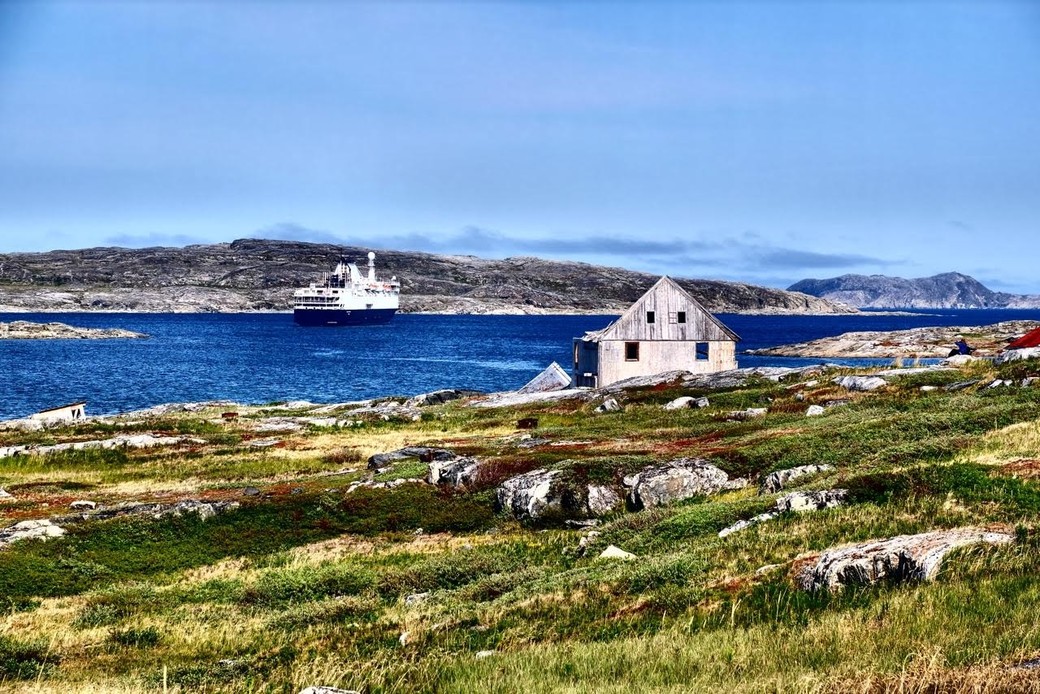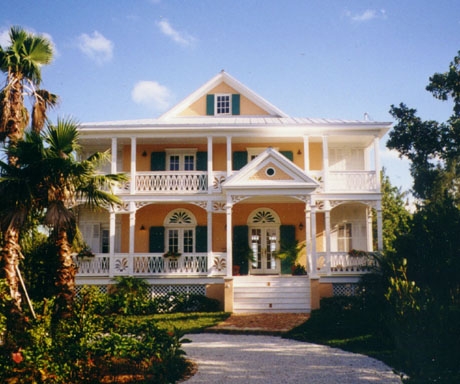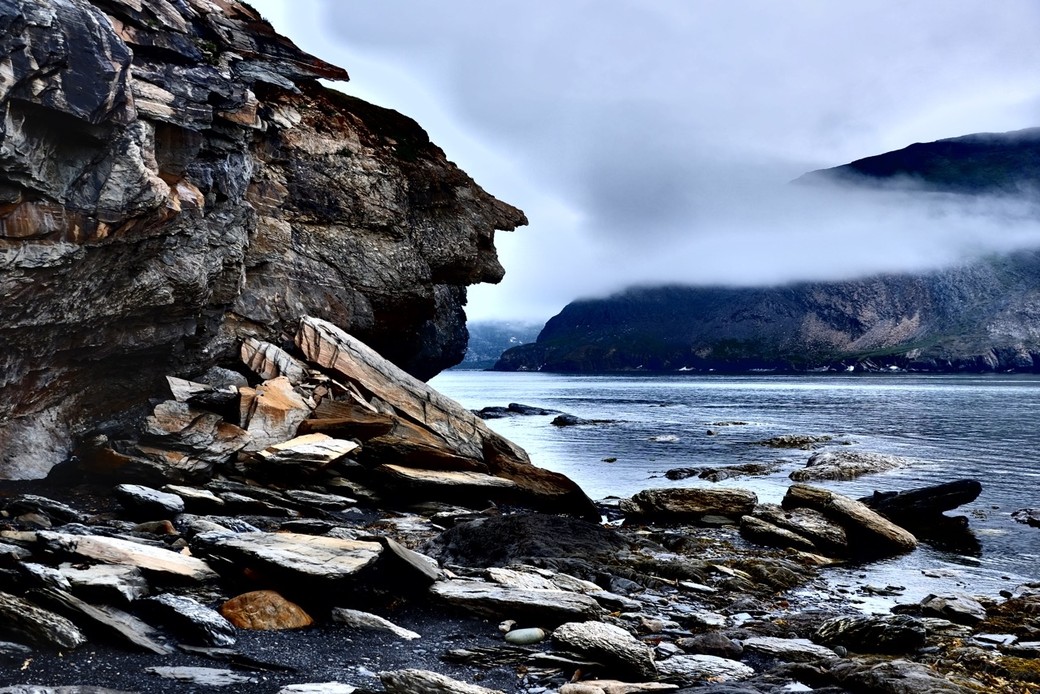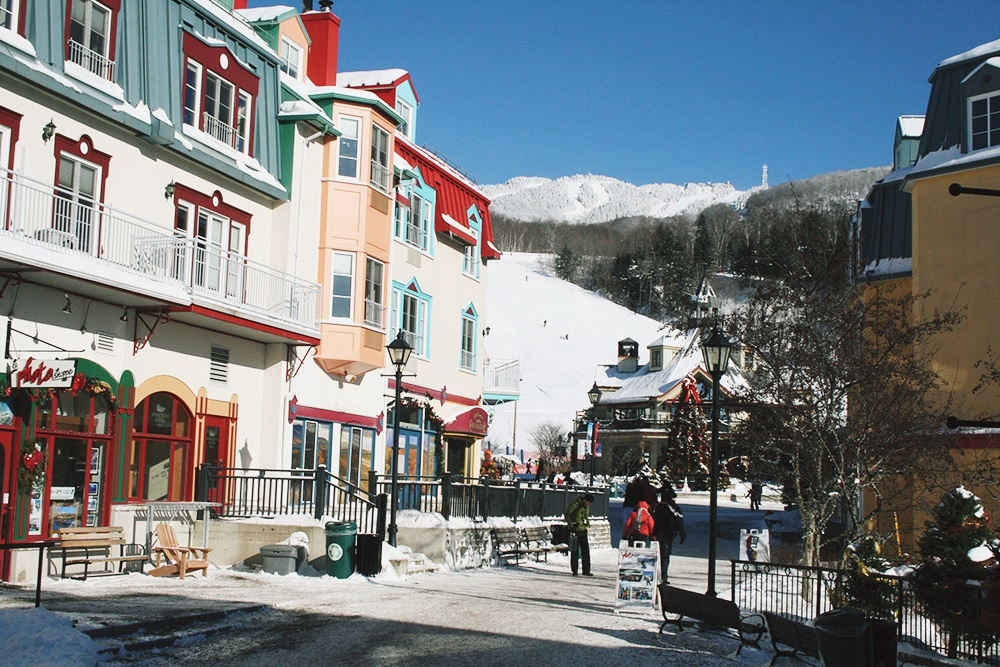
The Heart of Wild Labrador: Adventure Canada Style
All photos courtesy of Don MacLean.
Once in his life a man ought to concentrate his mind upon the remembered earth. He ought to give himself up to a particular landscape in his experience; to look at it from as many angles as he can, to wonder upon it, to dwell upon it. — SCOTT MOMADAY
Cruising north on the Labrador Sea marked a turning point in our adventure. After days of mostly sun and warmth, the first day on the Labrador Sea was unrelentingly grey, wet and cold. A dense fog only lifted late in the afternoon. The sea’s complexion was also different. Like the sky, it was grey and ominous; swells were at their most extreme. We swayed constantly as the Ocean Endeavour at once powered through and rode the waves. Through the grey and the wetness we would pass the occasional glacier, alone and starkly beautiful. The sense was palpable that we were heading towards more remote and more forbidding territory.
The day felt different for another reason as well. Adults sometimes like to lament how dependent children and teenagers have become on technology. A day spent without their tablet or smartphone can seem like an eternity and a real hardship. But the dependence extends to adults as well. As wonderful as the first week had been, I found it reassuring to be able to contact home at the end of each day. I had come to depend on the videos my spouse sent to me everyday of our four month old baby smiling and babbling. They provided a few moments of joy and acted like an anchor to home even as I was hundreds of miles away at sea. Truth be told, they also did much to assuage a lingering guilt I was experiencing over being away from our baby girl for so long. I was talking with my spouse on this grey and wet afternoon when the internet and phone connection was unexpectedly and irretrievably lost. Contact would not be renewed until the end of our trip. I would adjust, of course, but not before experiencing a peculiar sense of absence.
Nain and Kangiqsualujjuaq
The sun and the calmer weather had returned by the next day, when we arrived by Zodiac in Nain, a small Inuit community located north on Labrador’s east coast and the home of Jason Edmunds, one of our expedition leaders and a great singer and guitar player to boot. (On a cruise rich with wonderful musical performances, I think Jason’s performance the night before our arrival in Nain was the only one to garner a standing ovation.) There was a gathering of the community and the ship’s crew and passengers in the local Moravian church. A choir sang songs and we were welcomed – again in a spirit of warmth, generosity and celebration. This was followed by a walk through the community, a tour of the local school and a lesson. In an actual classroom a teacher taught us to pronounce a few letters and words in their native tongue.
Our time in Nain reflected a subtle but important change in emphasis. The places we were about to visit that were so remote to most of the ship’s passengers were home to Inuit communities. Our days would still consist of hikes and long walks in the heart of beautiful landscapes, but other days would be remembered most for the joyous spirit with which we were welcomed. Just as was true in Nain, it seemed as though the entire community was waiting at the shore to greet us when days later we arrived in Kangiqsualujjuaq. We thoroughly enjoyed samples of their cuisine – a delicious sea food chowder comes to mind – and the opportunity to simply talk. At the end of the day the community hosted a wonderful show of music and dancing. Two young women sang a throat song and a much larger group performed a series of dances. The atmosphere was festive. The community’s aim was to show us a grand time. They succeeded brilliantly.
Derek and Maria
Our immersion in Inuit culture and experience would go deeper. There were also opportunities to learn about their remarkable knowledge of the land and how recent history has shaped their ability to live their traditional way of life. Among the more conventional opportunities were good old fashioned talks given by different Adventure Canada staff members. Two Inuit staff gave separate talks, each reflecting different and challenging dimensions of life in Canada.
One only has to look at Derek to sense he possesses a combination of toughness and resourcefulness. He also embraces his culture. “The Inuit were born to live on the land,” he remarked early in his presentation. Hunting, he went on to say, is fundamental to the Inuit. Derek’s presentation included many images of him next to animals he had hunted and killed. Polar bears, seals, arctic hare, wolves, Canada Geese: he hunts them all. The hunt is motivated by the twin imperatives of need and respect. “You have to use what’s around you to survive,” he said at one point. But when hunting an animal you always kill it in a way “that it doesn’t suffer.” When using a rifle, he will kill the animal with a single shot aimed at the lungs or heart.
The thought occurred to me many time since stepping on the Ocean Endeavour that Adventure Canada’s idea is for passengers to engage with issues related to the land and its history. At no point was that idea more forcefully confirmed than when Maria – another staff person – spoke about her life as an Inuit woman. Maria is painfully shy and her life has been characterized by deep wounds and their consequent scars. She stepped in front of everyone, said how difficult talking was for her and, moments later, stepped off the stage. Maria wasn’t ready. Moments later she stepped back on and began to cry. The effect of the tears was to strengthen her resolve. What followed was more like a stream of consciousness than a carefully structured talk. That stream at many moments crystallized into a heartfelt and painful lament for a way of life that was stolen, if not ultimately lost. I say stolen because Maria’s family was among the community who were forcibly relocated from Hebron in 1959. In keeping with the strange but prevailing orthodoxy of the time, there was no consultation with the community whose lives were about to be turned upside down. Not only was there little consultation, there was very little actual communication between the government of the day and leaders of the community. Leaders of Hebron heard about the impending relocation as a rumour. When the rumour was verified, the community was promised the upheaval in their lives would be minimal. Promises of housing, jobs and the freedom to resume their traditional way of life were made, only to go unfulfilled. The combination of the relocation and the broken promises were enough to send her father into a tailspin from which he did not recover and which echoed down through his family. Maria suffered gravely from a litany of problems, all of which she traces back to the family’s relocation from Hebron. Sexual abuse, drug and alcohol abuse, alienation and despair. Only recently has she emerged from this long tunnel of darkness. The healing process has been long and painful and is not yet complete. But, as Maria made clear, she is in a much better place now.
The spirit in which they engage with Inuit communities is one of Adventure Canada’s many strengths.
Hebron
As Maria’s personal story highlighted, among the many challenging chapters in the history of Newfoundland and Labrador is the gradual or sudden demise of once thriving coastal communities. Hebron was founded as a Moravian missionary community some time around 1861. It is now deserted.
After a morning spent learning about Hebron’s brief history as a Moravian missionary community, passengers embarked on another thrilling afternoon of adventure. To the zodiacs we went. Upon arrival we walked among the beautiful but haunting relics of its past as a coastal community. There isn’t much that remains – a church as well as a few other dilapidated structures – but the effect is still to draw you back to a time when communities resided here. Later in the afternoon we embarked on a challenging but exhilarating hike. Under a blue sky, we trekked up mountains. We would reach a plateau only to look to see there was another hill to climb. At last we reached the final summit. Not for the first time on this adventure, I felt as though we were on top of the world.
At dinner that night it felt inevitable that Hebron would be a subject of discussion. The day, after all, was as much about relishing the extraordinary beauty of the place as thinking about it’s recent tragic past. I was enjoying the company of Billy, a sketch artist, and Rob and Robin, two videographers documenting various parts of the trip. How would the resettlement of the entire community be regarded, I asked, if the government had fulfilled its promises of housing and a resumption of the Inuit’s traditional way of life? Bill alluded to the practical challenges for any government of meeting a population’s education and medical needs. It was Robin’s remark, however, that has stayed with me most. In a way that we perhaps cannot understand, he suggested, the Inuit are truly of the land on which they live. To uproot them, especially in the undemocratic and disrespectful spirit in which it was done, was bound to produce the problems it did. Alienation, isolation, substance abuse.
Ramah Bay
The sky was overcast when we arrived at Ramah Bay. Heavy clouds lay low, shrouding the tops of the Torngat Mountains. Some people were expressing a wish for clearer skies, if not sunshine. I preferred the grey clouds. We disembarked early this morning, not long after breakfast. The place was another former Moravian mission post, established in the hope of securing the conversion of Inuit living North of their more southerly posts. The whole Moravian quest to convert Inuit to Christianity raises interesting questions for me. I wonder why the project of converting Inuit to Christianity was successful to the apparent extent it was. The Inuit’s own spirituality, after all, was as central to their world view and way of life as Christianity was to the Moravians. While standing in the remnant’s of the abandoned mission’s graveyard, I asked Tom Gordon this very question. Tom is a music historian and can be counted as one of the many friendly and knowledgeable Adventure Canada staff members. He remarked that the Inuit were – and remain – a highly pragmatic people. Incorporating elements of Christianity into their spiritual practises did not mean they abandoned their own. Nor did they give up their traditional ways of living. The Inuit would have resided at Ramah Bay for only a few months of the year. Otherwise they were elsewhere, hunting and sustaining themselves. The Moravians also constituted an important source of goods. Tom’s answer was a thoughtful one.
In his book Arctic Dreams, Barry Lopez offers a brilliant meditation on the Arctic’s endless dimensions. (The book was a serendipitous discovery in the Ocean Endeavour’s wonderfully stocked library.) Although we were not in the Arctic, so many of his insights seem applicable to the remote landscapes we visited, but one less so than all the others.
"In the face of a rational, scientific approach to the land, which is more widely sanctioned, esoteric insights and speculations are frequently overshadowed, and what is lost is profound."
There has indeed been tensions between the strictly scientific and the more spiritual, holistic and esoteric approaches taken to understanding such beautiful but challenging landscapes. Although those tensions have hardly been resolved, on this trip these competing approaches seem less mutually exclusive and more mutually reinforcing. They compliment each other. Those at Adventure Canada understand that to only engage in the science would be to miss out on the experience of being moved and indeed altered by such majestic landscapes. But to simply gaze at a mountain or the Bay in which it sits, without the context that good science provides, is also to risk missing something. It’s as though the more one learns how ancient mountains formed the deeper the spiritual experience of looking at them up close becomes. A geologist will tell how the age of rocks are measured and how mountains we’re walking among formed billion of years ago. Similarly, the science of archeology facilitates a deeper understanding and respect for ancient communities and cultures. As I was repeatedly discovering, it can become the springboard for thoughtful questions and discussions. The discovery of a sod house or an aboriginal tool allows the sensitive observer to imaginatively travel back in time. An ornithologist will help you identify what bird you see or hear soaring above the sea. A naturalist will explain the many different species of whales that inhabit the seas upon which we were sailing. With such an array of expertise, it’s hard to imagine that at least some of what one learns on an Adventure Canada cruise will not inspire or fascinate.
Eclipse Bay, Eclipse River and the Torngat Mountains
No one knew what to expect to find at Eclipse Bay, located on the northern tip of Labrador. It was the first visit for everyone on board, including Adventure Canada staff. The morning we arrived was just as we’d come to expect: the air was cool when we set foot in the Zodiac and the sky was overcast, but showing no threat of rain. Ideal conditions, in other words. We set off, walking on undulating mossy and rocky ground. The further we trekked the more it seemed as though we were all sharing in a beautiful discovery. We came upon a stream of rushing water, flowing away from a black mountain range wrapped in a low lying ribbon of cloud. Gradually the heavy clouds overhead dispersed, making way for a burst of sun and colour. The effect was to heighten the beauty of the rest of the landscape. The sun’s presence had the added effect of lifting everyone’s mood just that little bit more. There was a shared sense of how special and privileged an experience this was. Everyone, I thought, seemed suddenly closer. Any awkwardness in talking to people you didn’t know dissolved with the morning mist. The closeness will recede, of course, but the memory of the experience will not.
That shared exhilaration and closeness was also a function, no doubt, of time’s passing. The adventure was nearing its end. Following Eclipse Bay there was only one more full day at sea. The day after everyone would go their separate ways. Back to Winnipeg, Germany, New Zealand, Seattle, St. Johns, Colorado, Toronto, Ottawa – and all the other far flung places from whence people had come to make this journey. For this reason perhaps there was little rush to return to the ship. Yes there were strict timelines to follow, but the initial walk took less time than expected. There was still time to linger, to explore more of this majestic place. Most of us opted to hike the mountain immediately in front of us. We walked up the slope, laughing and chatting and stopping every few minutes to look and behold. Someone looked off in the distance and thought he saw a bear scaling a hillside. Even looking through binoculars, however, proved inconclusive. It hardly mattered. The higher we climbed the more breathtaking the vista. Upon reaching the summit the view was different depending on what direction one looked. In one direction was the ship, now looking like a miniature of itself as it rested in the calm waters of the bay. In another, was the black mountain and the low lying ribbon of cloud.
We returned to the shore with time still to spare. Zodiacs were waiting to take us to Eclipse Bay’s hidden gem – a waterfall at the end of an inlet that flows between towering cliffs comprised of ancient rock. When we arrived and saw the water rushing down it renewed our shared sense of discovery.

Walking on Eclipse Bay’s mossy and rocky ground, trekking up a mountain as the sun burst through the clouds and then riding on a Zodiac to the Falls: the day had already brimmed over with discovery and adventure. No one would have protested if the rest of the afternoon and evening were clear of activities. But, this being Adventure Canada, there were talks to attend if one so wished in the afternoon. As though to prove they think of everything, Adventure Canada also had what was cleverly referred to as the “Floating Book Club,” led by three esteemed Canadian authors, Terry Fallis, Doug Gibson and Kathleen Winter. Terry Fallis was humorous and often insightful about the state of Canadian politics when, earlier in the cruise, he discussed his breakout novel The Best Laid Plans. In addition to being an author, Doug Gibson is the great Canadian editor and publisher, storyteller and, it must be said, a real gentleman. His thoroughly entertaining talk on his relationship with a long line of Great Canadian authors – Alistair McLeod, Hugh MacLennan, Robertson Davies, Mavis Gallant, Alice Munro, among many others – was still to come. But it was Kathleen Winter’s talk and novel Annabel that most directly spoke to the experience of visiting Labrador especially. Annabel is about a child born with features of both genders, but it is as much about Labrador itself. The land’s rugged beauty and peculiar energy and its power to shape the lives of those who live there. She was giving her second talk this afternoon.
After being introduced by Doug Gibson, Kathleen gently bounded to the stage with her guitar in hand. In a voice initially tentative that then rose to fill the room, she started with a song, Harry Martin’s “A Place Called Labrador.” This beautiful rendition sung by an award winning author called to mind another, easily overlooked aspect of an Adventure Canada cruise – the multi-talented people they draw. Otherwise so much of what Kathleen said echoed my own experience and sentiments the adventure inspired. Energy, reverence, connectedness: the landscapes and people we are so privileged to visit give rise to these sorts of deeper impressions. The opening passages of Annabel describe Labrador as a place that speaks to those whose hearts and minds are open enough to hear. That idea, I slowly discovered, had taken root inside me. That’s when it struck me: these past few glorious weeks the land had been talking and I, at long last, was learning to listen.









